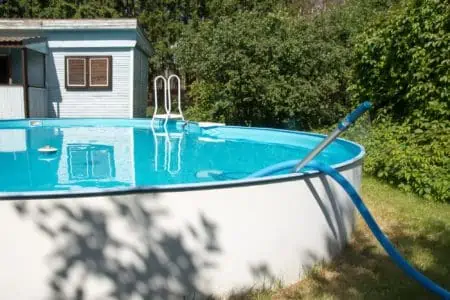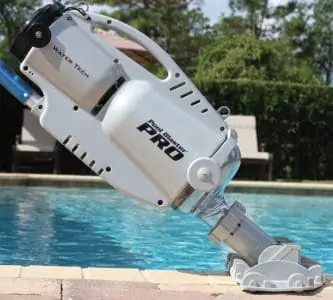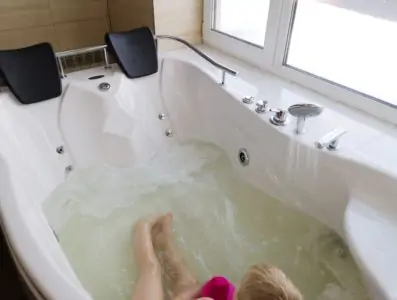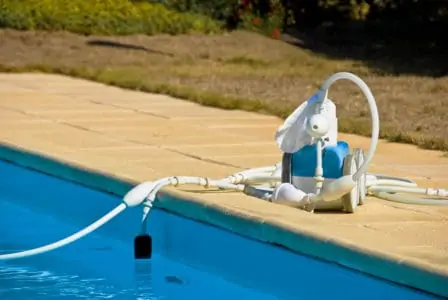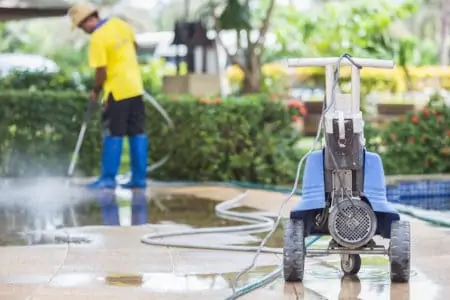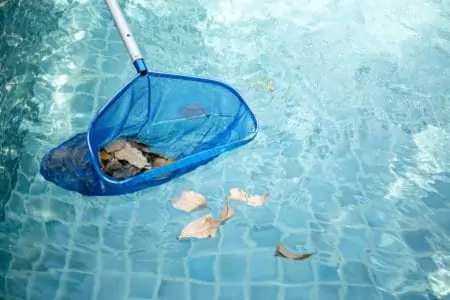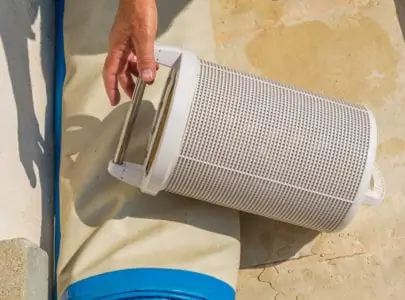If you have an above ground pool, then you know how important it is to keep your pool clean. No one wants to be swimming in cloudy, germ-filled water. There are quite a few steps for beginners to learn to maintain a pool.
So let’s discuss how to clean an above ground pool and keep it crystal clear for those summer days by the pool.
Key Takeaways
- Clean your above ground pool using a combination of a filter and pump, skimming, brushing, and vacuuming.
- Regularly test the water balance and shock your pool to keep it sanitized and safe for swimming.
- Perform daily, weekly, monthly, and yearly maintenance tasks to ensure your pool stays clean and healthy.
- Winterize your pool to protect it during colder months and maintain chemical balance.
What is the Best Way to Clean an Above Ground Pool?
Above ground pool cleaning sounds tricky. Thankfully the best way for cleaning an above ground pool is to use a combination of various methods to keep your pool clean.
You will need to invest in a good filter and pump. Scrap any debris from the surface of the pool and vacuum it. Also, you will need to clean and brush the interior of your pool to help keep algae and dirt from collecting on the sides and bottom.
The water will need to be tested regularly so you can maintain the water balance and periodically shock your pool.
How to Clean an Above Ground Pool
- Time: 1-2 hours
- Difficulty: Beginner
What You’ll Need
- Pool Filter
- Hose
- Spray Nozzle
- Skimmer net
- Leaf rake
- Brush with nylon bristles
- Telescopic pole
With a Pool Filter
The first thing you will need to do when you get an above ground pool will be to install a good pool filter and pump. It is best to get a professional to do this. The pump keeps the water circulating and pushes water through the filter. The filter cleans your water of all contaminants.
You will need to clean your pool filter regularly as the pool filter and pump are critical for good pool maintenance. Keep an eye on the pressure of your pool filter. When it rises, you will need to backwash a sand or DE filter.
To backwash your filter, follow the manufacturer’s instructions.
If your filter is a cartridge filter, you will need to pull it out and spray the filter with a garden hose to clean it. Check to be sure that the cartridge filter is in good shape. Otherwise, it will need to be replaced.
Clean the pump basket each week as it collects debris. Remove the basket, dump it out, and rinse it with a hose. Make sure it’s secure when you replace it.
By Hand
The filter and pump basket will not remove all the debris that falls into your pool. Instead, you will need to skim your pool at least once a day and you will also need to brush the walls of your pool every week to keep it clean.
1. Install a Skimmer Basket
If you can, also install a skimmer basket in your pool. It will collect small debris that falls into your pool. Be sure to empty it every 1-2 days. The advantage to having a skimmer basket is that you will not need to manually skim your pool as frequently.
2. Skim the Pool Manually
Use a flat skimming net to skim your pool and remove isolated debris every day. This will help you keep your pool clean.
At times a storm will cause quite a few leaves or other debris to fall into your pool. If this has happened, you can use a leaf rake to remove these items. It’s a bag that attaches to a telescopic pole so you can pull it across the pool gathering debris.
3. Brush the Pool
Once a week you will need to brush your pool. Do so by attaching a brush head to your telescopic pole. You will brush the walls of your pool in a downward motion to remove any dirt or algae that’s on the walls. Make sure you brush down to the bottom of the pool.
You will need to pay special attention to areas that don’t receive much water circulation such as the area behind the ladder. You can also use a smaller brush if it’s easier to clean smaller, hard to reach areas such as the ladder or at the top of the pool.
With a Vacuum
The pool filter, skimming, and brushing will only clean your pool to a point. You will need to vacuum your pool as well. Vacuuming your pool by hand is a time-consuming task, so you may wish to purchase an automatic vacuum to save you time.
The vacuum attaches to the filter system and removes dirt and debris. If you choose to vacuum manually, you will need to do so once or twice a week.
1. Skim the Pool
Make sure the pool has been skimmed and all debris has been removed.
2. Attach Vacuum to Telescopic Pole
You will need to attach a vacuum to a telescopic pole. Make sure it has brushes or rollers. They will help remove the dirt and debris from the bottom of the pool.
3. Attach Hoses
Attach a hose to your vacuum by putting the hose in the swivel end of the head. Place the vacuum in the pool and lean the pole along the side of the pool. This will prevent the pole from sliding into the pool while you’re attaching the hose to the vacuum.
When you’ve attached the hose to the vacuum head, you will put the vacuum head, telescopic pole and hose into the pool.
Now insert the other end of the hose into the skimmer return outlet. Remove the basket from the skimmer return outlet. Then put the loose end of the hose into the pool.
Hold it in front of the skimmer return outlet allowing the water to be pushed through the hose until bubbles stop coming out of the vacuum head. Insert the hose into the skimmer return outlet making sure that it’s firmly inserted.
4. Vacuum
Using the pole attached to your vacuum, vacuum the bottom of your pool. Make sure that you remove all the debris and that you overlap your vacuuming so that you effectively vacuum the pool twice.
Shocking the Water
Once a week you should consider shocking the water of your pool using a shock kit such as Super Shock Treatment Swimming Pool Chlorine Cleaner. This will increase the chlorine level dramatically so that contaminants are removed. It’s an excellent tool to use if your chlorine levels fall too low.
After you’ve shocked your pool, wait until the chlorine levels return to 3 or 4 ppm before using it again.
When you’re shocking the water, be sure to follow the manufacturer’s instructions to add shock to the water of your pool.
How to Clean an Above Ground Pool After Draining
After draining your above ground pool, you will need to clean the pool liner. This way the liner and walls of the pool will be sparkling clean when you add water to your pool again.
- Time: Afternoon
- Difficulty: Beginner
What You’ll Need
- Dish soap
- Bucket
- Sponge
- Garden hose
- Sump pump
- Drainage hose
1. Make the Cleaning Solution
Add enough dish soap to a bucket of water so that suds begin to form. You can also use a commercial pool liner cleaner instead of dish soap if you prefer.
2. Scrub the Liner
Use the sponge to gently scrub the pool liner. You don’t want to use too much force as you may tear it. Do ensure that you clean all of the pool liner.
3. Rinse
Use a garden hose to rinse the liner of your pool until all the soap has been removed. You may need to use a sump pump and a drainage hose to make sure that all the soapy water has been removed from your pool.
Make sure the water has been removed into a safe area.
How to Clean an Above Ground Pool That Has Been Sitting for Months
If your pool has been sitting around for months and has not been cleaned, it has likely turned brown or black from dirt and algae growth.
- Time: At least 24-48 hours
- Difficulty: Beginner
What You’ll Need
- Skimmer net
- Chlorine
- Shock
- Flocculent
- Pool vacuum
1. Clean Around the Pool
Clean the area around the pool before you begin cleaning the pool. Make sure that all sticks, twigs, furniture, etc. have been removed. Then clean up any dirt or mud that has gathered there so it doesn’t go into the pool.
2. Skim the Debris
A pool that has been neglected for several months likely has quite a bit of debris in it. Use a skimmer net to remove all the debris that you possibly can from your pool.
3. Run the Filter
Turn on the filter. It is an important part of cleaning your pool and will help to filter out contaminants.
4. Add Chlorine
You will need to add chlorine to your pool. Aim to add enough that the chlorine level is between 10ppm and 30 ppm.
5. Vacuum the Pool
Vacuum the pool to help remove more of the debris and small particles hanging in the pool.
6. Add Flocculent
Add some flocculent such as Cloroxx Sink to Clear Flocculent to your pool. The flocculent will cause the mud in your pool to clump together and sink making it easier to remove.
7. Test the Water Balance
Test the water balance of your pool.
8. Shock the Pool
You will need to shock the pool by using a shock kit like Super Shock Treatment Swimming Pool Chlorine Cleaner. This will help to remove all contaminants from your pool and rebalance the chlorine.
How to Care For an Above Ground Pool
To care for your above ground pool, you will need to keep the pool filter running at least 8 hours a day, skim debris from your pool daily and clean the pool weekly.
You will also need to check the chemical and pH balance regularly so that you can make sure your pool offers a healthy swimming environment for your family and friends.
Maintenance Checklist
There are daily, weekly, monthly, and yearly chores you should be doing to ensure that your pool stays clean and healthy. This will allow your family to enjoy swimming in your pool all summer long.
Daily
- Run the pool filter at least 8 hours a day.
- Check the filter pressure and how it’s operating.
- Check the water level to be sure it’s around the mid-skimmer level.
- Skim debris.
- Empty skimmer and pump baskets of debris.
- Check the chlorine level which should be between 2-4 ppm.
- Check the PH balance of your pool. It should be between 7.4 -7.6.
Weekly
- Skim the surface of your pool before vacuuming it.
- Brush your pool after vacuuming.
- Test the alkalinity which should be between 80-120 ppm.
- Add algaecide to kill the algae in the pool.
- Add clarifier and metal control as well.
- Clean area around the pool.
- Add chlorine tablets.
- Backwash your filter or clean it if the pressure has risen 8-10 PSI over the clean pressure.
- Shock the pool.
Monthly
- Test pool chemistry. Rebalance as needed.
- Check for algae developing in hard-to-clean areas of the pool.
- Clean the waterline and inside the skimmer walls.
Yearly
- Winterize the pool
Keeping the Pool Clean During Winter
You will need to prepare your pool for the cooler winter months when you will not be swimming in it regularly. Winterizing your pool will also help to keep it ready for your family after winter is over.
- Time: Afternoon
- Difficulty: Beginner
What You’ll Need
- Winterizing kit
- Pool cover
1. Remove Equipment
Remove all equipment from your pool including any skimmer baskets and ladders.
2. Drain and Clean the Filter Tank
Clean your filter. If you have a cartridge filter, then make sure that the cartridge is in good shape and completely dry before replacing it in the filter tank. Do not leave any moisture on it as it will sit in the tank for several months.
3. Clean Equipment and Drain the Hose
Clean all the equipment you had in your pool and drain the hose.
4. Balance the Pool Water
The balance of your pool water will change for the winter as it’s recommended that you raise the ph, alkalinity, and calcium hardness levels. You will also need to shock your pool.
Consider using a winterizing kit like In the Swim Pool – Winterizing and Closing Kit to make sure the chemical levels of your pool are ready for the winter.
5. Cover the Pool
Cover the pool to make sure that all debris is kept out of the tank. The cover will also help keep the weather from affecting the water balance and chemistry.
Above Ground Pool Cleaning Tips
- Add a solar blanket to the pool. This will increase the temperature by 15 degrees and help to maintain chemical balance.
- Winterize the pool correctly.
- Run the pump daily for at least 8 hours.
- Make sure the impeller of your filter pump remains unclogged.
- Patch and clean the liner.
- Apply a shock water treatment once a week.
- Vacuum more than once a week.
- Add a tennis ball to absorb oils in the pool.
- Clean and maintain the filter.
- Test water balance often.
